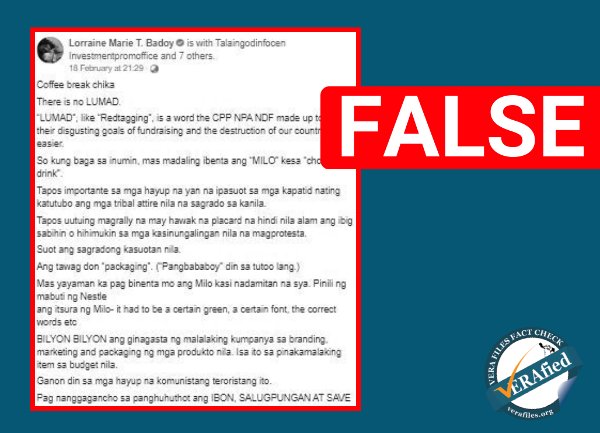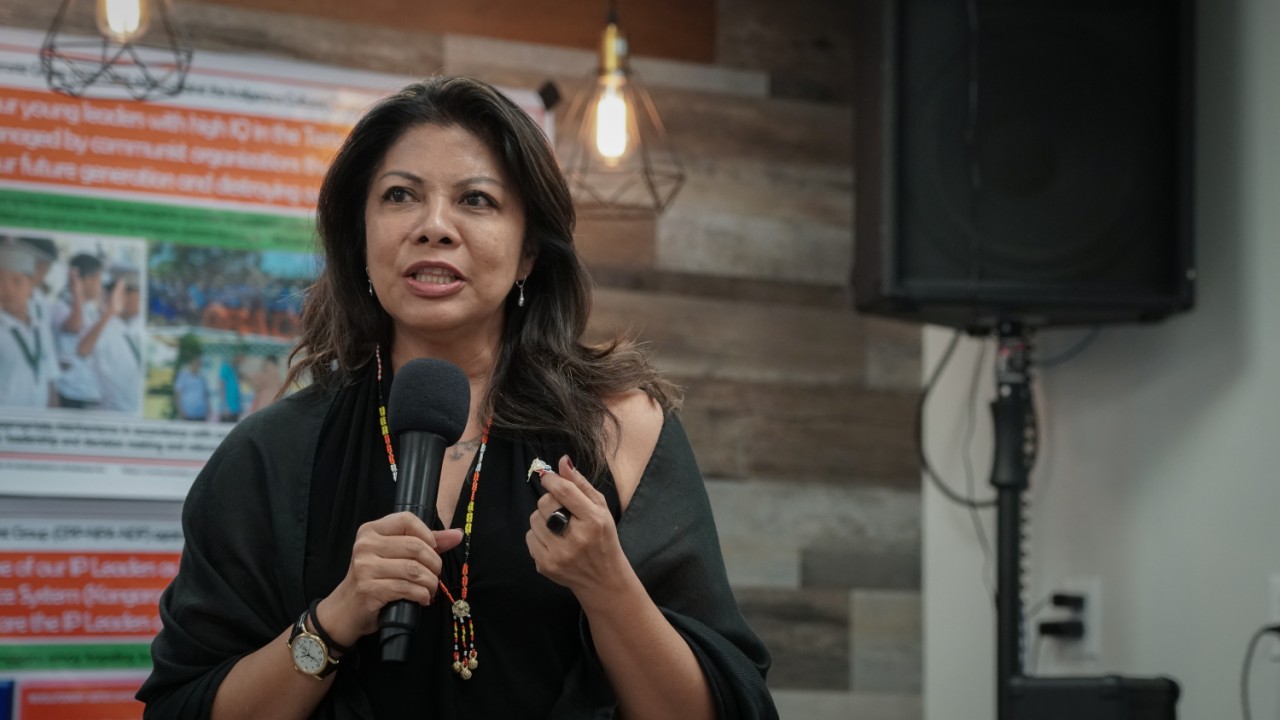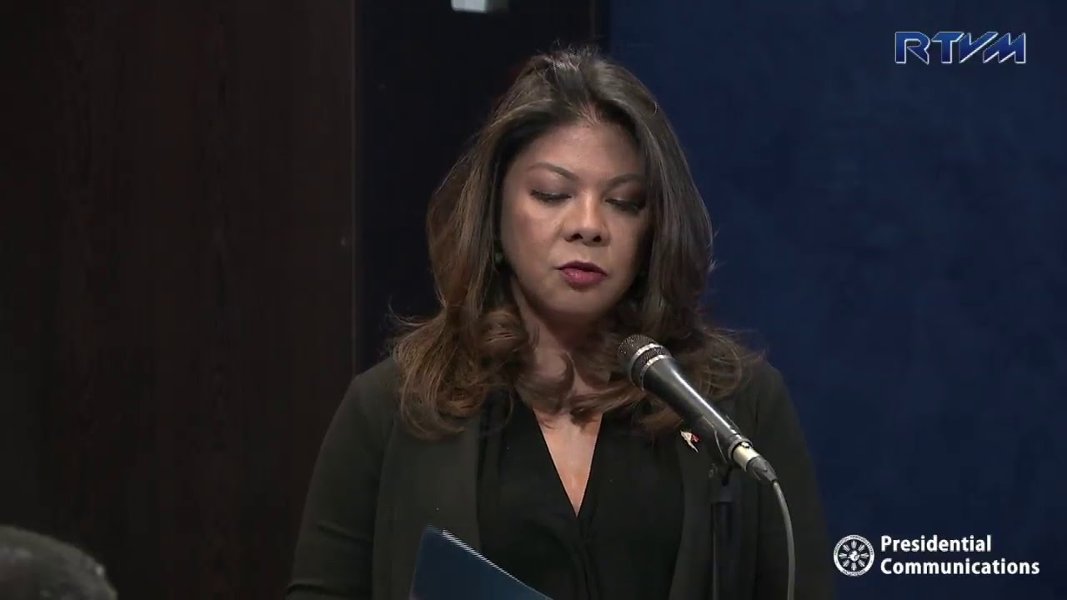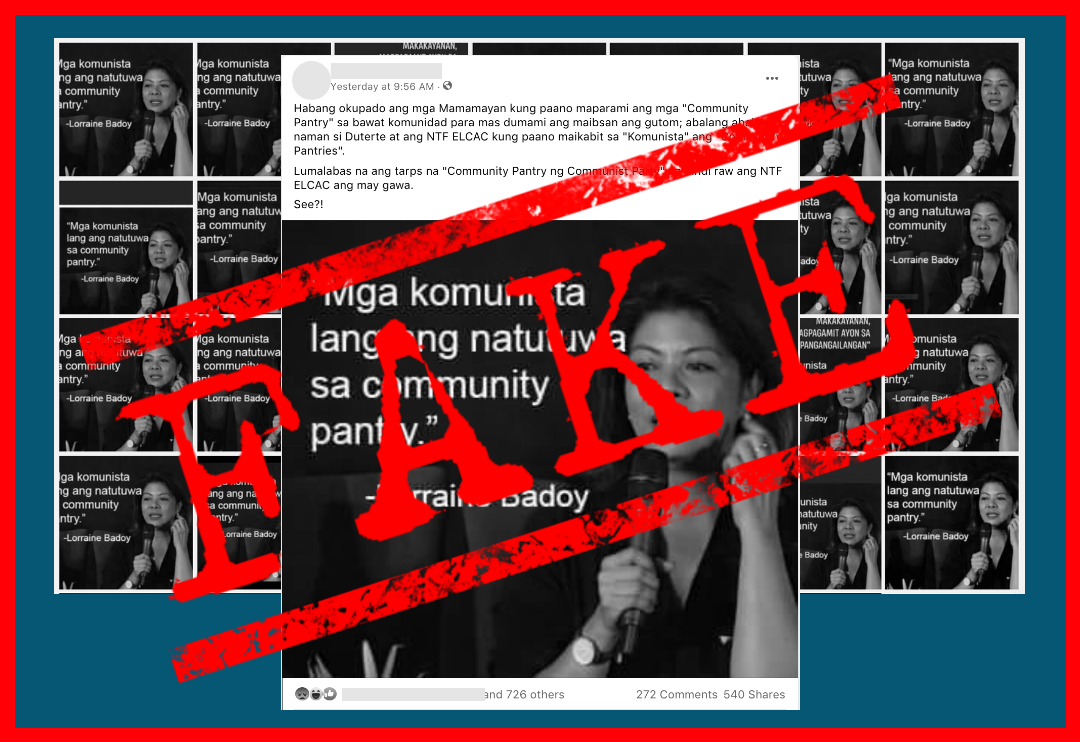We updated the list of Badoy’s previously flagged claims.
Last month, Communications Undersecretary Lorraine Marie Badoy denied the existence of a group of indigenous peoples in the country referred to as “Lumad,” wrongly claiming that it is a “made up word” of the Communist Party of the Philippines (CPP) and its allied organizations to forward their agenda.
She reiterated her false claim this week, and called a fact check article of her post a “lie.”
STATEMENT
In a Facebook (FB) post on Feb. 19, Badoy, concurrently the spokesperson of the National Task Force to End Local Communist Armed Conflict (NTF-ELCAC), said:
“Coffee break chika (gossip).
There is no LUMAD. ‘LUMAD’, like ‘Red[-]tagging’, is a word the CPP NPA (New People’s Army) NDF (National Democratic Front of the Philippines) made up to make their disgusting goals of fundraising and the destruction of our country easier.
So kung baga sa inumin, mas madaling ibenta ang ‘MILO’ kesa ‘chocolate drink’ (for instance in drinks, [the brand] ‘MILO’ is easier to sell than ‘chocolate drink’).”
Source: Communications Undersecretary Lorraine Marie Badoy official Facebook account, “Coffee break chika. There is no LUMAD…,” Feb. 19, 2021, see archived version
In the comments section, a netizen asked if the word “Lumad” was merely concocted.
Badoy responded and said it refers to just one tribe around Cebu, and “not all tribes in Mindanao” as the CPP-NPA-NDF supposedly made it appear.
FACT
Both of Badoy’s claims are false.
“Lumad,” a term recognized by Philippine law, is a Cebuano Visayan word for “native” that is recorded in the 1972 dictionary of Cebuano Visayan by John Wolff, a professor emeritus of linguistics at Cornell University. A copy of the dictionary entry was shared with VERA Files Fact Check by medical anthropologist Michael Tan, former chancellor of the University of the Philippines Diliman.
The term was adopted by 15 of at least 18 “ethnic groups” in Mindanao that are neither Moro nor Christian in an assembly 34 years ago, based on a 2015 article published on the website of the National Commission for Culture and the Arts.
The “collective decision” of the groups to use the term was made during the 1986 Cotabato Congress, where local and regional indigenous groups in Mindanao discussed “issues in their struggle for cultural determination within their respective ancestral lands,” according to a monograph on Lumadnon (plural of Lumad) published by the National Museum of the Philippines in 2020.
In an article published on Mindanews last December, Rudy Rodil, a Mindanaoan historian and former vice chair of the government’s peace panel with the Moro Islamic Liberation Front, wrote:
“The choice of a Cebuano word – Cebuano is the language of the natives of Cebu in the Visayas – was a bit ironic but it was deemed to be most appropriate considering that the various Lumad tribes do not have any other common language except Cebuano.”
Source: Mindanews.com, ANGAY-ANGAY LANG: The Minoritization of the Indigenous Communities of Mindanaw and Sulu (5), Dec. 1, 2020
While only 15 ethnolinguistic groups were involved in the agreement to use the term in the 1986 Congress, researchers said around 20 to 40 non-Muslim major and sub-groups fall under the Lumad category, noted the National Museum monograph.
The book identified 19 “major” Lumad groups: Ata, B’laan, Bagobo, Banwaon, Bukidnon, Dibabawon, Higaunon, Mamanwa, Mandaya, Manguwangan, Mansaka, Manobo, Matigsalug, Obo, T’boli, Tagakaolo, Talaandig, Teduray, and Subanen.
The term “Lumad” was officially adopted into Philippine law in August 1989, when Republic Act 6734, which created the Autonomus Region in Muslim Mindanao, was enacted. In using the term, the law differentiated the “Lumads” or “tribal peoples” in Mindanao from the Moros.
Badoy’s false claims came four days after the conduct of what police say was a “rescue operation” of minors who were allegedly being trained to become child warriors at the University of San Carlos retreat house in Cebu on Feb. 15.
A day later, Save Our Schools Network, a group of nongovernment organizations advocating for children’s right to education, said 25 Lumadnon were forcibly taken into custody, including two elders, two teachers and the students.
As of writing, Badoy’s post bearing the false claim has already garnered about 1,100 reactions and 3,321 shares on the platform.
The undersecretary’s Feb. 19 post was a 180-degree turn from an earlier FB status in October 2015, in which she acknowledged that Lumad are from Mindanao, and even sympathized with their plight.
Badoy, whose post was also fact-checked by Rappler last month, stood by her false claims. On March 2, the NTF-ELCAC spokesperson even red-tagged the media organization, claiming, without basis, that it is a “friend and ally of this terrorist organization [CPP-NPA-NDF].”
In the same post, she said her statement that the CPP-NPA-NDF’s use of the term “Lumad” to raise funds is “not a personal opinion but the official statement of the [NTF-ELCAC] and therefore the official stand of the Philippine government.”
VERA Files has twice flagged Badoy for her inaccurate claims, both of which are related to the CPP-NPA-NDF:
- VERA FILES FACT CHECK: Badoy errs in claiming NDF tagged as terror group by PH, other countries
- VERA FILES FACT CHECK: Badoy red-tags nun; incorrectly labels NDF a terror group, again
Editor’s note: We updated the list of Badoy’s previously flagged claims.
Sources
Communications Undersecretary Lorraine Marie Badoy official Facebook, Coffee break chika. There is no LUMAD, Feb. 19, 2021
National Task Force to End Local Communist Armed Conflict (NTF-ELCAC) Official Facebook, Retrieved on Feb. 28, 2021
Wolff, J. (1972). A dictionary of Cebuano Visayan. Lumad. pg. 640. Cornell University, Southeast Asia Program and Linguistic Society of the Philippines. Retrieved on March 3, 2021
Cornell University: The College of Arts & Sciences, The Department of Linguistics: John U. Wolff
Personal communication with Dr. Michael T. Tan of University of the Philippines (UP)-Diliman, March 3, 2021
Personal communication with Prof. Jose Monfred Sy of Department of Filipino and Philippine Literature, UP-Diliman, Feb. 27, 2021
University of the Philippines-Diliman, Curriculum Vitae of Michael Tan. Retrieved on March 3, 2021
National Commission for Culture and the Arts, LUMAD in Mindanao, April 16, 2015
National Museum of the Philippines Ethnology Division, Lumad Mindanao 2020
Montiel, C., Rodil, R., Guzman, J. (2012). The Moro Struggle in Southern Philippines. The Moro Struggle and the Challenge to Peace Building in Mindanao, Southern Philippines. Retrieved on Feb. 26, 2021
Mindanews.com, ANGAY-ANGAY LANG: The Minoritization of the Indigenous Communities of Mindanaw and Sulu (5), Dec. 1, 2020
Official Gazette of the Philippines, Republic Act No. 6734: An Organic Act for the Autonomous Region in Muslim Mindanao, Aug. 1, 1989
Philippine National Police Official Facebook page, POLICE RESCUE 19 LUMAD MINORS UNDERGOING CHILD WARRIOR TRAINING IN CEBU, Feb. 15, 2021
Save our Schools Network Official Facebook page, STATEMENT: On the blatant attack and illegal arrest of 26 lumad students, teachers and elders of Bakwit School in Cebu, Feb. 16, 2021
Communications Undersecretary Lorraine Marie Badoy official Facebook, A few days ago, my daughter told me something she learned in school…, Oct. 27, 2015
Rappler.com, FALSE: Lumad is a word made up by the CPP-NPA-NDF, Feb. 25, 2021
(Guided by the code of principles of the International Fact-Checking Network at Poynter, VERA Files tracks the false claims, flip-flops, misleading statements of public officials and figures, and debunks them with factual evidence. Find out more about this initiative and our methodology.)




